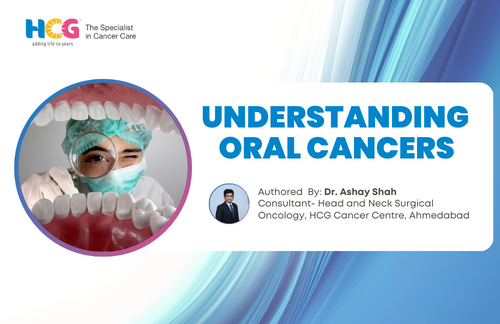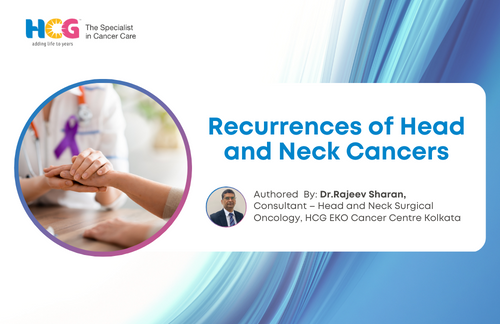
30 May, 2025

30 May, 2025
Do you know which is the "Oral Cancer Capital of the World?"
The answer might surprise you. It is India. In our country, oral cancer is the most common cancer among men, and among women, it is the 3rd most common cancer.
Oral cancer is a type of head and neck cancer that affects the tissues of the mouth/oral cavity. Oral cancer occurs when the cells present in the mouth or throat region start dividing abnormally and form a tumour. Although treatable, this condition can be life-threatening if it is not diagnosed in the early stages and managed appropriately.
The Prevalence of Oral Cancer in India
57.5% of the world’s oral cancer cases are reported in India. The average age for an oral cancer diagnosis in our country is around 50. Another shocking observation is that about 60–80% of oral cancer patients see a doctor in the advanced stage. This could also be one of the contributing factors to the poor 5-year survival rates for oral cancer in India.
Another contributing factor to the increased oral cancer incidence is the lack of awareness among our country’s population. A survey found that a large percentage of participants did not know that cancer could occur in the head and neck region and the most common cause is tobacco. So, in the case of oral cancer, it is not just the incidence that is alarming, but also ignorance.
Cancers in Different Subsites of the Oral Cavity
Oral cancer can occur in different parts of the mouth, including:
The appropriate diagnosis of oral cancer is of paramount importance. The subsite where cancer begins can impact treatment planning and disease prognosis significantly.
Oral Cancer Signs & Symptoms:
Early diagnosis and timely treatment are imperative for the successful management of oral cancers. Therefore, individuals must be aware of the different symptoms of oral cancer and seek immediate medical attention when any symptom lasts for more than 2 weeks.
Some of the common symptoms associated with oral cancer include:
These symptoms do not always point towards cancer, as these are associated with other, less severe health conditions as well. Therefore, it is important to see a doctor for a conclusive diagnosis.
Risk Factors for Oral Cancers:
One of the biggest risk factors for oral cancer is tobacco use. This includes smoking cigarettes, cigars, and pipes, as well as chewing tobacco. People who consume large amounts of alcohol and tobacco are at even greater risk, especially when both products are used regularly.
Other risk factors include:
Men are twice as likely to get oral cancer as women. The earlier the stage at diagnosis, the higher the chance of survival after treatment. The five-year overall survival rate in those with stage 1 and 2 oral cancers is typically per cent. This makes timely diagnosis and treatment all the more important.
Oral Cancer Diagnosis
First, the doctor will perform a physical exam. This includes closely examining the roof and floor of the mouth, the back of the throat, tongue, and cheeks, and the lymph nodes in the neck. If there is any tumour, growth, or suspicious lesion, a tissue biopsy would be advised. A tissue biopsy involves removing a piece of the tissue so it can be examined under a microscope for cancerous cells.
In addition, the doctor may perform one or more of the following tests:
Oral Cancer Treatment
Treatment for oral cancer will vary depending on the type, location, and stage of cancer at diagnosis.
Cancer care is a multi-disciplinary team approach which includes:
Surgery: Primary modality for oral cancer treatment is surgery. It involves the removal of tumours from all sides with an adequate margin which may require the removal of the entire or part of the jaws & also the removal of lymph nodes from the neck. Advanced technologies like LASER, robots, microscopes, and high precision saws are now available.
Radiation therapy: Radiation therapy involves aiming radiation beams at the tumour. It can be used after surgery or as primary treatment with or without chemotherapy. Latest techniques like IMRT, IGRT, and Tomotherapy-H are available for better results with minimum side effects.
Chemotherapy: Chemotherapy is a treatment where a specific drug is injected or given orally in the body that kills cancer cells. It is given before surgery to shrink the disease or after surgery with radiation. It can be taken on an outpatient basis, although some may require hospitalization.
Reconstruction and Rehabilitation
Bottom Note
At HCG, we have a dynamic team of cancer specialists that approaches oral cancers with a multidisciplinary and patient-centric approach. We specialise in devising a personalised treatment plan for every cancer patient to ensure that we achieve the best possible clinical outcome, and cancer is nothing more than a chapter in each patient’s life.
